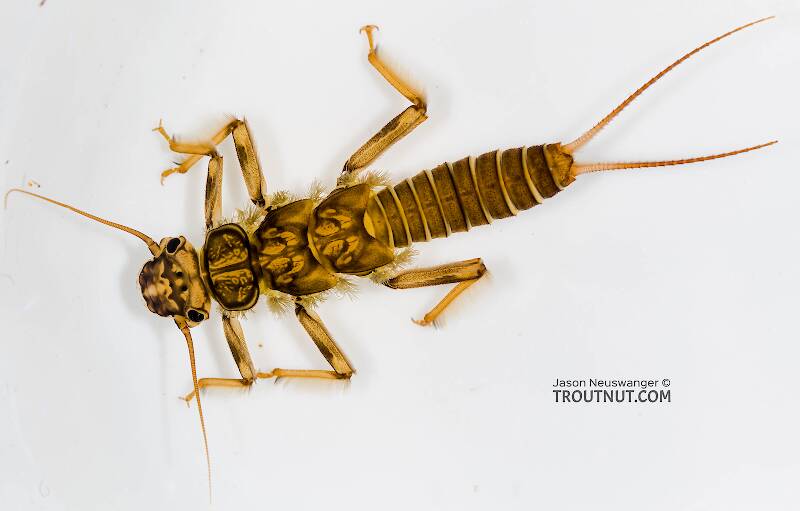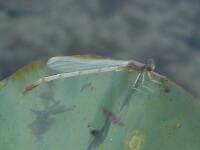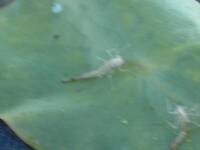
Salmonflies
Pteronarcys californica
The giant Salmonflies of the Western mountains are legendary for their proclivity to elicit consistent dry-fly action and ferocious strikes.
Featured on the forum

Troutnut is a project started in 2003 by salmonid ecologist Jason "Troutnut" Neuswanger to help anglers and
fly tyers unabashedly embrace the entomological side of the sport. Learn more about Troutnut or
support the project for an enhanced experience here.
Acemajor on Dec 6, 2009December 6th, 2009, 3:49 pm EST
hi every one, i am just getting into fly fishing, havnt been yet though. i am just reading up on rods,reels and flies. i was wondering if it is possible to tie a live insect to a hook and use it as a fly. it sounds possible enough but wanted to know if you really could and if so, how. any other advice you want to give me would also be greatly apprecitated. thank you.
Taxon on Dec 6, 2009December 6th, 2009, 9:58 pm EST
Hello Freeman-
Yes, it is possible, but would certainly not be fly fishing, nor would it be legal in Washington's Fly Fishing Only or Selective Gear Rules waters, as use of an artificial fly is required, and what you are suggesting would be classified as fishing with Bait, even if you were to use a fly rod and fly line to present it.
Please allow me to suggest your reading a book titled Curtis Creek Manifesto by Sheridan Anderson. It is written in a comic-book-like style, but will quickly familiarize one with fly fishing terminology and techniques.
Is it possible to tie a a live insect to a hook and use it as a fly?
Yes, it is possible, but would certainly not be fly fishing, nor would it be legal in Washington's Fly Fishing Only or Selective Gear Rules waters, as use of an artificial fly is required, and what you are suggesting would be classified as fishing with Bait, even if you were to use a fly rod and fly line to present it.
Please allow me to suggest your reading a book titled Curtis Creek Manifesto by Sheridan Anderson. It is written in a comic-book-like style, but will quickly familiarize one with fly fishing terminology and techniques.
Acemajor on Dec 7, 2009December 7th, 2009, 8:08 am EST
great thank you i will be sure to check that out
Acemajor on Dec 7, 2009December 7th, 2009, 8:08 am EST
great thank you i will be sure to check that out
RleeP on Dec 7, 2009December 7th, 2009, 9:09 am EST
I don't know if tying a life insect to a hook would work for me with my temperment..
If I get stuck in a tree (or here in the midwest, in high grass) on the backcast, I undergo a pretty stark transformation depending on how things go. Before the first tug/attempt to free the hook, I smile and give it a go. If it doesn't work, I shrug and chuckle, but most of my smile is disappearing and the next tug is a little more imperative and insistent. I may mutter once or twice here.. If that doesn't work, I get downright ugly and reach a cusp. If I can physically control myself, I follow the leader back to the snag and unhook it. If I lose control, I yell out "my way or the highway, you #@^^%&&!!!" and usually yank hard enough to lose the fly.
I never can really predict which way this last part of the drama is going to go...:)
Given that, if I had to tie live bugs to hooks, I'd probably end up institutionalized in short order...:)
Welcome to the forum, Ace! There are literally centuries of fly fishing experience here, mostly from guys who both love to share their knowledge and are also more emotionally stable than I..:) Its a good place to hang out when you're first starting.
Best,
Lee
If I get stuck in a tree (or here in the midwest, in high grass) on the backcast, I undergo a pretty stark transformation depending on how things go. Before the first tug/attempt to free the hook, I smile and give it a go. If it doesn't work, I shrug and chuckle, but most of my smile is disappearing and the next tug is a little more imperative and insistent. I may mutter once or twice here.. If that doesn't work, I get downright ugly and reach a cusp. If I can physically control myself, I follow the leader back to the snag and unhook it. If I lose control, I yell out "my way or the highway, you #@^^%&&!!!" and usually yank hard enough to lose the fly.
I never can really predict which way this last part of the drama is going to go...:)
Given that, if I had to tie live bugs to hooks, I'd probably end up institutionalized in short order...:)
Welcome to the forum, Ace! There are literally centuries of fly fishing experience here, mostly from guys who both love to share their knowledge and are also more emotionally stable than I..:) Its a good place to hang out when you're first starting.
Best,
Lee
UPTroutBum on Dec 7, 2009December 7th, 2009, 4:52 pm EST
I living or dead insect such as a maylfy would not hold up to the casting and repeatedly landing on the water, and now that I picture this it just sounds awfully bad for the insect. Stick to tied flies and you'll have plenty of fun and hopefully some good luck. Presentation is key to fooling a trout. Live, dead, or artificial bait doesn't look appetizing if it is moving in an unnatural way.
For reading, check out some of Orvis's books by Tom Rosenbauer.
For reading, check out some of Orvis's books by Tom Rosenbauer.
" The true fisherman approaches the first day of fishing season with
all the sense of wonder and awe of a child approaching Christmas." John Voelker
all the sense of wonder and awe of a child approaching Christmas." John Voelker
Mcjames on Dec 11, 2009December 11th, 2009, 1:54 am EST
I lived for a time in the former Yugoslavia and this was a common technique among the locals, using live (or dead, I guess) nymphs. They would put 3-4 insects on a hook at a time. Very effective
I am haunted by waters
Oldredbarn on Dec 11, 2009December 11th, 2009, 2:54 am EST
James,
Is Cortland Manor anywhere near Cortland NY? The family of my wifes father is from there.
I don't want to encourage anything here in terms of river fishing with bait, but in Michigan a live Hex nymph is killer for Perch through the ice in winter. We call them "Wigglers" and in the old days some guys made their beer money from digging them up to sell in bait shops.
I have run in to a group of guys on the Huron river near Ann Arbor a couple times that harvest hellgramites from under rocks and fish with them there.
Spence
Is Cortland Manor anywhere near Cortland NY? The family of my wifes father is from there.
I don't want to encourage anything here in terms of river fishing with bait, but in Michigan a live Hex nymph is killer for Perch through the ice in winter. We call them "Wigglers" and in the old days some guys made their beer money from digging them up to sell in bait shops.
I have run in to a group of guys on the Huron river near Ann Arbor a couple times that harvest hellgramites from under rocks and fish with them there.
Spence
"Even when my best efforts fail it's a satisfying challenge, and that, after all, is the essence of fly fishing." -Chauncy Lively
"Envy not the man who lives beside the river, but the man the river flows through." Joseph T Heywood
"Envy not the man who lives beside the river, but the man the river flows through." Joseph T Heywood
Mcjames on Dec 14, 2009December 14th, 2009, 12:51 pm EST
Hi Spence. No, Cortlandt Manor is in northern Westchester County, near Peekskill. But there is another guy on this site from Cortlandt NY. He puts up some great flyfishing videos on youTube sometimes..
I am haunted by waters
Tod
Posts: 1
Posts: 1
Tod on Jan 2, 2010January 2nd, 2010, 9:23 am EST
Hi Acemajor,
Actually there are a couple of bugs you can attach to a hook useing a couple of very small thin rubber loops on a #16 to #10 hook. This works well for both live grasshoppers and dragonfly nymphs and I simply call it a harness.
You need to find the strongest small/thin rubber strands you can find. For the grasshopper, the loops should be about an 1/8 inch in diameter and an 1/8th" apart. For the dragon fly nymph both the loop and distance apart should be slightly more. Th loops should of course be tied on the top of the hook.
On the grasshopper, the hook needs to go on the top or over it's back with the hook part pointing straight up from the hopper's back. The front loop goes over the head fitting just on the inside of the chin and the back loop goes aroung the body and wings with the wings inside of the loop. The legs and thorax should both end up between the loops.
On the dragon nymph it's the opposite, the hook goes on the bottom with the front loop over the head and the back loop over the tail but again with the thorax and legs in between the loops.
They can be a little difficult to load but I started out useing the small pointed end of a fingernail clipper handle that worked pretty good with a little practice. Eventually I created a small loader that attached right to my fly rod just above the reel.
As far as casting goes it takes a little practice but it's amazeing how much a grasshopper can take. If the loops are made right and the hopper is loaded properly they'll take a pretty good bashing.
Of course the dragon fly nymph is a lake fly so they work best being trolled either out of a slow boat or a tube without much casting being involved. I primarily use a fast sinking line for this.
This is a deadly setup which is why I don't use it anymore. If you are a catch and release fisherman then forget about everything I've mentioned. Even with barbless hooks it'll kill most of the fish you catch because they swallow it.
Being new here I sure hope I haven't offended anyone with this, I'm an old fart who's tied my own flies for most of my life and although I'm not a purest I know what it means (and totally respect that) so please forgive me if I have.
Tod
Actually there are a couple of bugs you can attach to a hook useing a couple of very small thin rubber loops on a #16 to #10 hook. This works well for both live grasshoppers and dragonfly nymphs and I simply call it a harness.
You need to find the strongest small/thin rubber strands you can find. For the grasshopper, the loops should be about an 1/8 inch in diameter and an 1/8th" apart. For the dragon fly nymph both the loop and distance apart should be slightly more. Th loops should of course be tied on the top of the hook.
On the grasshopper, the hook needs to go on the top or over it's back with the hook part pointing straight up from the hopper's back. The front loop goes over the head fitting just on the inside of the chin and the back loop goes aroung the body and wings with the wings inside of the loop. The legs and thorax should both end up between the loops.
On the dragon nymph it's the opposite, the hook goes on the bottom with the front loop over the head and the back loop over the tail but again with the thorax and legs in between the loops.
They can be a little difficult to load but I started out useing the small pointed end of a fingernail clipper handle that worked pretty good with a little practice. Eventually I created a small loader that attached right to my fly rod just above the reel.
As far as casting goes it takes a little practice but it's amazeing how much a grasshopper can take. If the loops are made right and the hopper is loaded properly they'll take a pretty good bashing.
Of course the dragon fly nymph is a lake fly so they work best being trolled either out of a slow boat or a tube without much casting being involved. I primarily use a fast sinking line for this.
This is a deadly setup which is why I don't use it anymore. If you are a catch and release fisherman then forget about everything I've mentioned. Even with barbless hooks it'll kill most of the fish you catch because they swallow it.
Being new here I sure hope I haven't offended anyone with this, I'm an old fart who's tied my own flies for most of my life and although I'm not a purest I know what it means (and totally respect that) so please forgive me if I have.
Tod
Cdcaddis18 on Jan 6, 2010January 6th, 2010, 1:52 pm EST
"You need to find the strongest small/thin rubber strands you can find. For the grasshopper, the loops should be about an 1/8 inch in diameter and an 1/8th" apart. For the dragon fly nymph both the loop and distance apart should be slightly more. The loops should of course be tied on the top of the hook."
Personally I prefer the Zap-A-Gap Glue method. Before I go to the river I apply some very small pieces of thin rubber to my bait hooks with glue. Then you go and catch about a dozen big stoneflies or dragonfly nymphs. Then tie on a 2XL1XF #12 hook onto a piece of 5X. Then put a drop of waterproof glue on the rubber pads and apply the live nymph to the little drops of glue. Wait until the glue dries and then do a gentle side cast with your 13' noodle rod and center pin reel and just watch that bobber as you lay off a nice 150' drift down the Little J. Man those big browns just love that naturally appearing live bait. Then you put 'em on a stringer so you can cull out the little ones and just keep the big 'uns. Man do they ever taste good fried up with corn meal!
Personally I prefer the Zap-A-Gap Glue method. Before I go to the river I apply some very small pieces of thin rubber to my bait hooks with glue. Then you go and catch about a dozen big stoneflies or dragonfly nymphs. Then tie on a 2XL1XF #12 hook onto a piece of 5X. Then put a drop of waterproof glue on the rubber pads and apply the live nymph to the little drops of glue. Wait until the glue dries and then do a gentle side cast with your 13' noodle rod and center pin reel and just watch that bobber as you lay off a nice 150' drift down the Little J. Man those big browns just love that naturally appearing live bait. Then you put 'em on a stringer so you can cull out the little ones and just keep the big 'uns. Man do they ever taste good fried up with corn meal!
Quick Reply
Related Discussions
Topic
Replies
Last Reply
1
Jul 11, 2008
by Taxon
by Taxon






